What to do when your Washing Machine Stops Mid Cycle
It’s rather annoying when you’re washing your clothes and all of a sudden the washing machine stops mid cycle. Not only will you have to deal with a load of soaking clothes, but you will also have to get to the root cause of the issue, which can be a task in itself. We’ve put this article together to outline the most common reasons why your washing machine stops mid cycle and what you can do to fix the issue.
Last updated - 17/10/2022
Estimated reading time - 11 minutes
Is it normal for my washing machine to stop mid cycle?
Brief stops during a wash cycle are completely normal and are part of the washing process. As the washer drum turns to agitate the clothes inside, it will stop for a few seconds before turning in the opposite direction.
Before starting the troubleshooting process, wait for a few minutes to see whether your washing machine continues spinning or if it stops indefinitely. If it stops for a long time and does not go on to spin, there may be an issue, which we will try to help you resolve.
What should I do if my washing machine stops mid cycle?
Check there is power to the washing machine
If your washing machine stops mid cycle, the first thing to do is check the power supply. Check that the plug is switched on and that electricity is being supplied to your property. Check your fuse box to see if any fuses have tripped. If everything looks as it should, then there may be a fault with the washing machine or plumbing.
Reset your washing machine
If you have no power issues, the next thing you should try if your washing machine stops mid cycle is to reset it. If your washing machine is not full of water and you are able to open its door, quickly open and close it six times in 12 seconds. This is a general reset technique that works for most washing machines. If there is some water in the drum, the washing machine door will not open, so you will not be able to perform this reset technique.
If you have successfully reset your washing machine, you can now try washing your laundry again. If your washing machine stops mid cycle again, continue reading to find out what to do next.
Avoid unexpected costs.
With a Smart Plan cover policy, you can rest easy knowing if there's an issue with your washing machine, we'll usually have you back up and running within 48 hours.
Why does my washing machine stop mid cycle?
The washing machine isn't draining
If your washing machine stops mid cycle, it may be because it is unable to drain water. If it has stopped mid cycle, and you can see water inside the drum, this will most probably be the cause.
Depending on the program you have selected, your washing machine will go through these stages: prewash, wash, rinse, and spin. When your washing machine enters its rinse cycle, it’ll fill with water. Once it finishes rinsing your clothes, it has to empty all the water before moving on to the spin cycle. If it can’t, then it will stop until the water has been drained.
A common cause of a washing machine not draining is a blocked drain pump filter or drain hose.
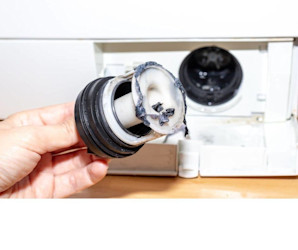
The drain pump filter’s purpose is to stop obstructions from interfering with the washer. A build up of detergent or fabric softener, obstructions such as lint, coins, hair bands, or other debris, will end up in the drain pump filter. If it is clogged, your washing machine will not be able to release wastewater, which will result in the machine stopping.
The drain hose carries wastewater out of your washing machine, and like the pump filter, if obstructions are blocking it, water will not be able to drain properly and could be the reason why your washing machine stops mid cycle.
In order to clear the drain pump filter or drain hose of obstructions, you will first need to drain your washing machine.
If your washing machine has a lid that you lift up from the top to load it with your laundry, you have a top loading washing machine.
- Turn off and unplug the washing machine.
- Get a bucket and lay down some towels around the machine in case there is a spill.
- If you have a freestanding washing machine, pull it away from the wall and locate the locate the drain hose at the back of the washing machine. The drain hose is the grey ribbed hose. Make sure you do not confuse the drain hose for the water inlet hose.
- Follow the drain hose to find where it leads. It is usually plumbed into the waste pipe under the sink, and can be unclamped or unscrewed.
- Detach the drain hose and place its end in your bucket. Water from inside the washing machine should now be draining into the bucket.
- Once no more water is draining, reattach the drain hose to the u-bend and mop up any spillages. Push your washing machine back into place.
- Plug your washing machine back in and restart your washing.
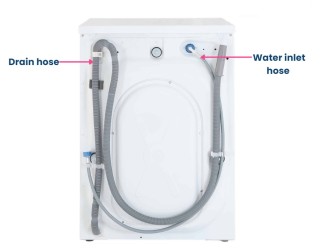
If your washing machine has a door on the front of it that you open to load it with your laundry, you have a front loading washing machine
- Turn off and unplug your washing machine.
- Get a bucket and a shallow container, and lay down some towels in case there are any spills or leaks.
- Locate the drain pump filter and drain hose. Most front load washing machines will have a separate drain hose next to the drain pump filter. You can find the drain pump filter and drain hose behind a flap on the bottom corner of the front of your washing machine (see image).
- If your washing machine has a drain hose next to the pump filter, pull it out and place its end in the bucket. When you are ready to drain the water, unscrew the cap on the end of the drain hose.
- If there is no drain hose, place the shallow container directly underneath the drain pump filter and slowly turn the knob until water comes out.
- Continue until no more water is coming out of the drain hose or pump filter.
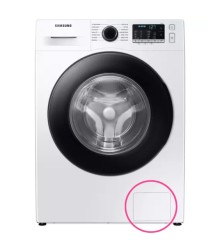
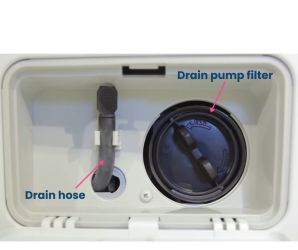
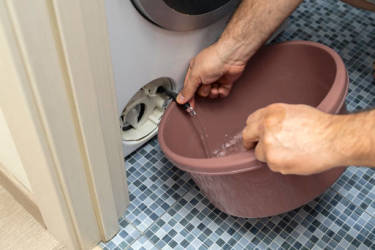
Now that you have drained your washing machine, you can now unblock its drain hose or pump filter.
- Remove the washing machine’s back panel. This can usually be done by removing a few screws, but you should check your manual to find out exactly how to remove the panel for your washing machine.
- Unclamp the drain hose with a pair of pliers. The drain hose should be connected to a drain pump somewhere along the bottom of the machine (see image).
- Follow the hose up the back of the washing machine and remove the fasteners securing it in place.
- Pull the hose out through the opening on the back of the machine.
- Detach the other end of the drain hose. You will need to follow the drain hose to find where it leads to. It is usually plumbed into a u-bend under the sink and can be unclamped or unscrewed.
- Once you have detached the hose from the machine and the u-bend, conduct a visual inspection of it to see if anything is clogged inside.
- To unclog the drain hose, you can pour hot water down the hose, use a chemical drain unblocker or a tool such as a plumbing snake. A plumbing snake is a flexible auger (drill bit) that is used to dislodge more stubborn blockages in a plumbing system.
- Once you have unclogged the drain hose, feed it back through the opening at the back of the washing machine and reattach it to the u-bend and drain pump. Clip it back into the fasteners inside the washing machine and screw the back panel back into place.
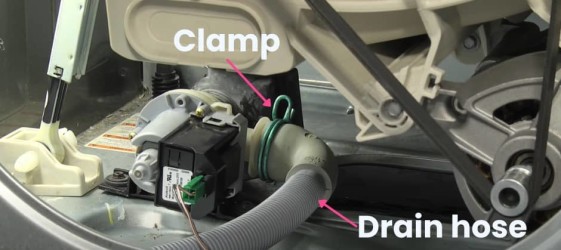
- Pull out the drain pump filter.
- Clear the filter of any obstructions.
- Once you have cleared the filter of obstructions, run it under some water and give it a clean. Be sure to clear it of any residue and then wipe it dry.
- Put the filter back in the washing machine and turn the knob to lock it in place.
- Close the flap.
- Clear up any spills.
Now that your washing machine has been drained and the drain hose and pump filter are unblocked, you can now turn your washing machine back on and try washing your clothes again .
Faulty control board
If your washing machine’s control board isn’t working properly, then the washing machine won’t function as it should and it could be the reason why your washing machine stops mid cycle.
A washing machine control board is essentially the brains of the operation. It controls the timing and execution of all the functions of the washing machine. Everything your washing machine does, from agitating to determining the water temperature, is controlled by the control board.
If the control board is defective, you might notice irregular responses such as your washing machine stopping mid cycle, the drum not spinning, water not draining, etc. You will need a qualified technician to diagnose and replace a faulty control board.
Faulty door or lid switch
A front load washing machine will have a switch behind the door lock that tells the washing machine’s control board when the door is open or shut. When the door is shut, a signal will be sent to the control board to let it know that it is safe to continue the washing process.
Similarly to the door switch on a front loader, the lid switch on a top load washing machine tells the control board if the lid is opened or closed.
If your washer’s door or lid switch is defective, your washing machine will assume the door or lid is open and will not operate. This could be why your washing machine stops mid cycle.
If you’re not an appliance engineer, it may be difficult to diagnose a faulty door switch yourself. An appliance engineer will be able to locate the door switch and test its electrical output, look for signs of wear and tear around the wires, check for loose connections, and fix it if necessary.
If you are confident with appliance repairs, you can test the door or lid switch with a multimeter. A multimeter is a handheld device used to measure electrical voltage, current, and resistance, and will be able to test if your switch is working.
You can buy a multimeter online for as little as £5.
- Turn off and unplug the washing machine.
- Access the switch. Gaining access to a lid or door switch differs depending on the make and model of your washing machine, but it usually involves removing the control panel on a top loading washer or the front panel on a front loading washer. You can search online to find out how to access your washing machine’s door or lid switch.
- Once you have gained access to the switch, disconnect it from its docking.
- Calibrate your multimeter and set it to the lowest setting for ohms of resistance. If you’re not sure how to do this, refer to its manual.
- Make sure the switch button is in the off position. Touch one of the switch’s terminals with one of the probes and another terminal with the other probe. If you have a reading above 0.5 ohms, then your switch is functioning correctly and will not be the cause of your washing machine stopping mid cycle.
If you have a reading below 0.5 ohms, the switch is faulty and will need to be replaced. - If you have a faulty switch and want to replace it, you can remove it by unscrewing any screws and disconnecting any wires connected to it. Replace the faulty switch with a new one, attach the wires to it, and screw it back into place.
The price of a new door or lid switch will vary depending on the make and model of your washing machine, but usually costs between £5 and £35. - Once you have replaced the lid or door switch, put the control panel or front panel back on securely.
- Turn the washing machine back on, and run a test wash to check that the lid switch is working.
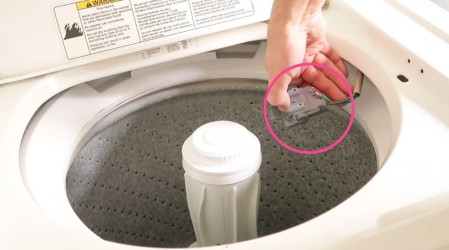
A worn or damaged drive belt
The drive belt is what turns the drum via the washing machine’s motor. If it breaks or is slipping, then your washing machine drum will not spin.
The first sign of a worn drive belt is your washing machine making a squealing noise. Another sign is the smell of burning rubber. If your washing machine stops mid cycle and you are able to open the door, try turning the drum with your hand. If you don't feel any resistance whatsoever when trying to rotate the drum, there might be a problem with the drive belt.
If you experience any of these signs, it's best to take action right away as the problem will persist until the drive belt breaks.
While it is possible to change the drive belt yourself, it is quite a complex task and getting it wrong can cause your washing machine to malfunction and need further repairs. If you think you may have a drive belt issue, we recommend you contact a washing machine engineer to diagnose and fix it. Drive belts are relatively inexpensive, and the process of changing them is straightforward for a well trained technician, so parts and labour for this repair shouldn't set you back too much.
Let us fix your washing machine.
At Smart Plan we have thousands of engineers up and down the country who are ready to fix your issue. We guarantee an engineer to your property within 48 hours.

